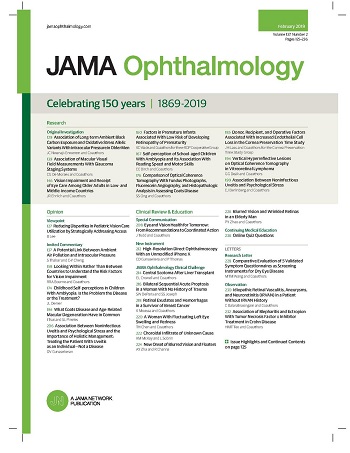与治疗胆管癌的成纤维细胞生长因子受体抑制剂相关的白内障
IF 7.8
1区 医学
Q1 OPHTHALMOLOGY
引用次数: 0
摘要
重要性由于成纤维细胞生长因子受体抑制剂(FGFRi)被用于治疗肝内胆管癌(iCCA),因此有必要了解在临床实践中长期使用后可能出现的并发症。目的 描述接受 FGFRi 治疗的 iCCA 患者白内障形成或恶化的病例,并描述 FGFRi 相关性白内障的眼科特征、风险因素和预后。这项回顾性病例系列研究使用了加利福尼亚大学旧金山分校肝胆组织库和登记处提供的携带 FGFR2 畸变的 iCCA 患者的数据,这些患者在临床试验中接受了 FGFRi 治疗,或将其作为标准疗法。数据收集自2015年2月至2021年10月期间的患者就诊情况,本次回顾性调查于2022年9月6日至2023年5月4日进行。数据分析于2023年5月5日至2023年9月6日进行。暴露使用FGFRi治疗iCCA。主要结果和测量指标主要结果为使用FGFRi后出现新的或恶化的白内障。白内障形成与临床协变量之间的关系采用非配对t检验和费舍尔精确检验进行统计分析。研究采用单一的双变量逻辑回归模型来检验 FGFRi 治疗的总持续时间和 FGFRi 治疗结束时的年龄是否是白内障发生的预测因素。结果 共有 18 名患者参与研究;患者年龄的中位数(范围)为 54(27-81)岁,13 名患者(72%)为女性。九名患者(50%)在开始使用 FGFRi 后至少有一只眼睛出现白内障或白内障进展。在 17 眼白内障患者中,8 眼(47%)需要进行白内障手术。一名患者迅速发展为白内障,并伴有相性青光眼,需要紧急手术治疗。从开始使用 FGFRi 到白内障发生或恶化的中位时间(范围)约为 18(1-23)个月。停用 FGFRi 后,9 名患白内障或白内障恶化的患者中有 5 名(56%)被诊断为新发白内障或白内障恶化。与未患白内障的患者相比,患白内障的患者接受 FGFRi 治疗的中位时间(范围)更长(13 个月 [2-26] vs 5 个月 [1-11];几率比 1.01;95% CI,1.00-1.02;P = .02)。尽管由于研究设计的原因,这项回顾性病例系列研究无法确证因果关系,但研究结果强调了白内障的形成或发展是 FGFRi 治疗的潜在不良反应,支持考虑对接受这种治疗的患者进行定期眼科检查。本文章由计算机程序翻译,如有差异,请以英文原文为准。
Cataracts Associated With Fibroblast Growth Factor Receptor Inhibitors for Cholangiocarcinoma.
Importance
Since fibroblast growth factor receptor inhibitors (FGFRi) are used for treatment of intrahepatic cholangiocarcinoma (iCCA), understanding potential complications following longer-term use in clinical practice settings is warranted. This study describes cataract formation or progression as a complication of FGFRi use for the treatment of iCCA, even after treatment discontinuation.
Objective
To describe cases of cataract formation or worsening in patients with iCCA treated with FGFRi and to characterize the ophthalmologic features, risk factors, and outcomes for FGFRi-associated cataracts.
Design, Setting, and Participants
This retrospective case series study used data from patients with iCCA harboring FGFR2 aberrations who received FGFRi in clinical trials or as standard therapy from the University of California, San Francisco, Hepatobiliary Tissue Bank and Registry. Data were collected from patient visits between February 2015 and October 2021, and this retrospective investigation was conducted from September 6, 2022, to May 4, 2023. Data analysis was conducted from May 5, 2023, to September 6, 2023.
Exposure
Use of an FGFRi for the treatment of iCCA.
Main Outcomes and Measures
The primary outcome was designated as development of a new or worsening cataract after FGFRi initiation. Statistical analysis for the association between cataract formation and clinical covariates was performed using unpaired t tests and Fisher exact tests. A single bivariate logistic regression model was used to examine total duration of FGFRi therapy and age at the conclusion of FGFRi therapy as predictors of cataract development.
Results
A total of 18 patients were included in the study; median (range) patient age was 54 (27-81) years, and 13 patients (72%) were female. Nine patients (50%) developed a cataract or had cataract progression in at least 1 eye after initiation of FGFRi. Of 17 eyes with cataract, 8 eyes (47%) required cataract surgery. One patient rapidly developed a cataract associated with phacomorphic glaucoma, which required urgent surgery. The median (range) time to cataract onset or worsening from initiation of FGFRi was approximately 18 (1-23) months. Five of 9 patients (56%) who developed cataracts or had cataract progression were diagnosed with new or worsening cataracts after discontinuation of FGFRi. Patients who developed cataracts had longer median (range) duration of FGFRi treatment compared with patients who did not develop cataracts (13 months [2-26] vs 5 months [1-11]; odds ratio, 1.01; 95% CI, 1.00-1.02; P = .02).
Conclusions and Relevance
While this retrospective case series study cannot prove cause and effect conclusively due to the study design, study results highlight cataract formation or progression as a potential adverse effect of FGFRi therapy, supporting consideration of periodic eye examinations in patients who have received this treatment.
求助全文
通过发布文献求助,成功后即可免费获取论文全文。
去求助
来源期刊

JAMA ophthalmology
OPHTHALMOLOGY-
CiteScore
13.20
自引率
3.70%
发文量
340
期刊介绍:
JAMA Ophthalmology, with a rich history of continuous publication since 1869, stands as a distinguished international, peer-reviewed journal dedicated to ophthalmology and visual science. In 2019, the journal proudly commemorated 150 years of uninterrupted service to the field. As a member of the esteemed JAMA Network, a consortium renowned for its peer-reviewed general medical and specialty publications, JAMA Ophthalmology upholds the highest standards of excellence in disseminating cutting-edge research and insights. Join us in celebrating our legacy and advancing the frontiers of ophthalmology and visual science.
 求助内容:
求助内容: 应助结果提醒方式:
应助结果提醒方式:


